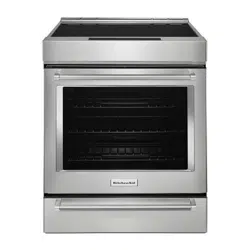Documents: Go to download!
- Owner's manual - (English, French)
- KEY USAGE TIPS
- FEATURE GUIDE
- COOKTOP
- OVEN
- RANGE CARE
- TROUBLESHOOTING
Table of contents
User Guide Electric Induction Range
KEY USAGE TIPS
AquaLift® Self-Cleaning Technology
AquaLift® Self-Cleaning Technology is a first-of-its-kind cleaning solution designed to minimize the time, temperature, and odors that ordinarily come with traditional self-cleaning methods. With AquaLift® Self-Cleaning Technology, an exclusive coating on the interior of the oven, is activated with heat and water to release baked-on soil. To use AquaLift® Self-Cleaning Technology, simply wipe out loose debris, pour water into the oven bottom, and run the AquaLift® Self-Cleaning cycle. When the cycle finishes in under 1 hour at a lower temperature than in traditional self-cleaning methods, just wipe out the remaining water and loose debris. See the “Clean Cycle” section for more detailed instructions. For additional information, frequently asked questions, and videos on using AquaLift® Self-Cleaning Technology, visit our website at http://whirlpoolcorp.com/aqualift.
Surface Temperatures
When the range is in use, all range surfaces may become hot, such as the knobs and oven door.
Baking Drawer When the oven is in use, the drawer may become hot. Do not store plastics, cloth, or other items that could melt or burn in the drawer.
Oven Vent The oven vent releases hot air and moisture from the oven and should not be blocked or covered. Do not set plastics, paper, or other items that could melt or burn near the oven vent.
Preheating
When beginning a Bake, Convect Bake, or Convect Roast cycle, the oven will begin preheating after Start is pressed. The oven will take approximately 12 to 15 minutes to reach 350°F (177°C) with all of the oven racks provided with your oven inside the oven cavity. Higher temperatures will take longer to preheat. The preheat cycle rapidly increases the oven temperature. The actual oven temperature will go above your set temperature to offset the heat lost when your oven door is opened to insert food. This ensures that when you place your food in the oven, the oven will begin at the proper temperature. Insert your food when the preheat tone sounds. Do not open the door during preheat before the tone sounds.
Ceramic Glass Cooktop Cleaning
To avoid damaging the cooktop, do not use steel wool, abrasive powder cleansers, chlorine bleach, rust remover, or ammonia.
1. Remove food/residue with the Cooktop Scraper.
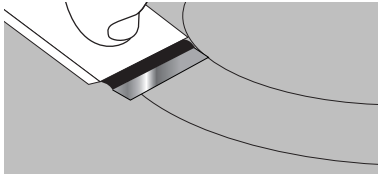
- For best results, use the Cooktop Scraper while the cooktop is still warm but not hot to the touch. It is recommended to wear an oven mitt while scraping the warm cooktop.
- Hold the Cooktop Scraper at approximately a 45° angle against the glass surface and scrape the residue. It will be necessary to apply pressure in order to remove the residue.
Allow the cooktop to cool down completely before proceeding to Step 2.
2. Apply a few dime-sized drops of affresh® Cooktop Cleaner to the affected areas.
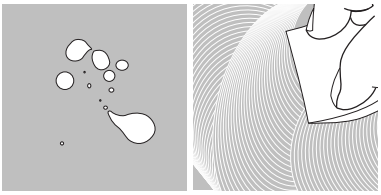
- Rub affresh® Cooktop Cleaner onto the cooktop surface with the blue Cooktop Cleaning Pad. Some pressure is needed to remove stubborn stains.
- Allow the cleaner to dry to a white haze before proceeding to Step 3
3. Polish with a clean, dry cloth or a clean, dry paper towel.
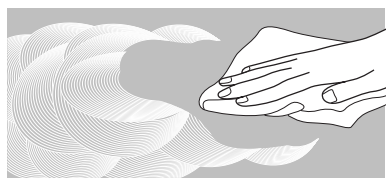
- Repeat steps 1 through 3 as necessary for stubborn or burned-on stains.
The Complete Cooktop Cleaner Kit is available for order and includes the following:
- Cooktop Scraper
- affresh® Cooktop Cleaner
- Blue Cooktop Cleaning Pads
FEATURE GUIDE

CLOCK/TOOLS: Clock
The Clock can use a 12- or 24-hour cycle. See the “Electronic Oven Controls” section.
- Press CLOCK/TOOLS until “CLOCK” is displayed.
- Use the number keypads to set the time of day.
- Press START to change the time.
- Press “3” for AM or “6” for PM.
CLOCK/TOOLS: Settings
Enables you to personalize the audible tones and oven operation to suit your needs. See the “Electronic Oven Controls” section.
OVEN LIGHT: Oven cavity light
The oven light is controlled by a keypad on the oven control panel. While the oven door is closed, press OVEN LIGHT to turn the light On and Off. When the oven door is opened, the oven light will automatically come On.
TIMER SET/OFF: Oven timer
The Timer can be set in hours or minutes up to 9 hours and 59 minutes.
- Press TIMER SET/OFF.
- Press the number keypads to set the length of time in hr-min-min. Leading zeros do not have to be entered. For example, for 2 minutes, enter “2.”
- Press TIMER SET/OFF to begin the countdown. If enabled, end-of-cycle tones will sound at end of countdown.
- Press TIMER SET/OFF again to cancel the Timer and return to the time of day.
- Do not press the Cancel keypad because the oven will turn off.
- If the Timer is running but not in the display, press TIMER SET/OFF to display the countdown for 5 seconds.
START: Cooking start
The Start keypad begins any oven function. If Start is not pressed within 2 minutes after pressing a keypad, the function is canceled and the time of day is displayed.
CANCEL UPPER CANCEL LOWER (on some models): Range function
The Cancel keypad stops any function for the appropriate oven or drawer, except the Clock and Timer.
BAKE: Baking and roasting
- Press BAKE.
- Set the desired temperature between 170°F and 500°F (75°C and 260°C) using the number keypads. The default temperature is 350°F (180°C).
- Press START.
- To change the temperature, repeat steps 2 and 3.
- Press CANCEL UPPER when finished.
STEAM BAKE
- Insert the steam rack with water reservoir in the oven.
- Pour 11 /2 cups (350 mL) of warm water into the water reservoir. NOTE: Do not fill past the MAX mark.
- Press STEAM BAKE.
- Press the number keypad to select the desired food option.
- Press the number keypads to set the temperature.
- Press START.
- (Optional) Press COOK TIME. Press the number keypads to set the cook time.
- Press START.
- Insert food when preheating finishes.
- Press CANCEL UPPER when finished. NOTE: Let oven cool before removing and emptying water reservoir.
BROIL: Broiling
- Press BROIL.
- Press the number keypads to set the desired temperature.
- Press START and allow the oven to preheat for 5 minutes.
- To change the temperature, repeat steps 2 and 3.
- Position the cookware in the oven, and then close the door.
- Press CANCEL UPPER when finished.
PROOF: Proofing bread
- Place prepared dough in oven. Press PROOF.
- Press START.
- Let the dough rise until nearly doubled in size. Proofing time may vary depending on dough type and quantity.
- Press CANCEL UPPER when finished proofing. Refer to the “Proofing Bread” section for more information.
KEEP WARM: Hold warm
Food must be at serving temperature before placing it in the warmed oven.
- Press KEEP WARM.
- Set the desired temperature between 145°F and 190°F (63°C and 88°C) using the number keypads. The default temperature is 170°F (75°C).
- Press START.
- Press CANCEL UPPER when finished.
EASY CONVECT BAKE: Convection cooking
- Press EASY CONVECT BAKE.
- Press “1” to have the oven automatically convert the temperature and time for convection baking. Press “2” to manually convert the temperature and time.
- Press the number keypads to set a temperature other than 325°F (177°C) in 5° increments between 170°F and 500°F (77°C and 260°C).
- Press START.
- (Optional) Press the number keypads to set a cook time.
- Press START.
- To change the temperature, repeat steps 2 and 3.
- Press CANCEL UPPER when finished.
EASY CONVECT BROIL: Convection cooking
- Press EASY CONVECT BROIL.
- Press “1” to have the oven automatically convert the temperature and time for convection baking. Press “2” to manually convert the temperature and time.
- Press the number keypads to set a temperature other than 325°F (177°C) in increments between 170°F and 500°F (77°C and 260°C).
- Press START.
- (Optional) Press the number keypads to set a cook time.
- Press START.
- To change the temperature, repeat steps 2 and 3.
- Press CANCEL UPPER when finished.
EASY CONVECT ROAST: Convection cooking
- Press EASY CONVECT ROAST.
- Press “1” to have the oven automatically convert the temperature and time for convection baking. Press “2” to manually convert the temperature and time.
- Press the number keypads to set a temperature other than 325°F (177°C) in 5° increments between 170°F and 500°F (77°C and 260°C).
- Press START.
- (Optional) Press the number keypads to set a cook time.
- Press START.
- To change the temperature, repeat steps 2 and 3.
- Press CANCEL UPPER when finished
COOK TIME: Timed cooking
Timed cooking allows the oven to be set to turn on at a certain time of day, cook for a set length of time, and/or shut off automatically.
To set a Timed Cook or a Delayed Timed Cook, see the “Cook Time” section.
BAKING DRAWER BAKE (on some models): Baking drawer
- Press BAKING DRAWER BAKE.
- Set the desired temperature between 170°F and 451°F (75°C and 233°C) using the number keypads. The default temperature is 350°F (180°C).
- Press START.
- To change the temperature, repeat steps 2 and 3.
- Press CANCEL LOWER when finished.
BAKING DRAWER SLOW COOK (on some models): Slow cook drawer
- Press BAKING DRAWER SLOW COOK.
- Set the desired temperature between 145°F and 190°F (63°C and 88°C) using the number keypads. The default temperature is 170°F (75°C).
- Place the food(s) in the Baking Drawer.
- Press START.
- (Optional) Set the desired cook time using the number keypads.
- Press START to begin heating the Baking Drawer.
- Press CANCEL LOWER when finished.
BAKING DRAWER KEEP WARM (on some models): Warming drawer
Food must be at serving temperature before placing it in the warmed oven.
- Press BAKING DRAWER KEEP WARM.
- Set the desired temperature between 145°F and 190°F (63°C and 88°C) using the number keypads. The default temperature is 170°F (75°C).
- Press START.
- Press CANCEL LOWER when finished.
AQUALIFT SELF CLEAN: Clean cycle
See the “Clean Cycle” section.
START (Control Lock Hold 3 Sec): Oven control lockout
- Check that the oven is OFF.
- Press and hold START (Control Lock Hold 3 Sec) for 3 seconds.
- A tone will sound, and “Control Locked” will scroll, and then “Locked” will be displayed.
- Repeat to unlock. No keypads will function with the controls locked. The cooktop functions are not affected by the oven control lockout.
CLOCK/TOOLS: Energy save
- Press CLOCK/ TOOLS until “ENERGY SAVE” is displayed.
- The current setting will be displayed.
- Press the “1” keypad to adjust the setting.
- Press CANCEL to exit and display the time of day. If Energy Save is ON, the range will go into Sleep mode after 5 minutes of inactivity. Any keypad press will activate the display. If Energy Save is OFF, the display will be ON at all times.
Electronic Oven Controls
Control Display - The display will flash when powered up or after a power loss. Press CANCEL UPPER to clear. When the oven is not in use, the time of day is displayed. If the range is in Energy Save mode, the display will be blank when not in use.
Tones - Tones are audible signals, indicating the following:
- One Tone
- Valid keypad press
- Oven is preheated (long tone).
- Function has been entered.
- Reminder, repeating each minute after the end-of-cycle tones
- Three Tones - Invalid keypad press
- Four Tones - End of cycle
Use the Clock/Tools keypad to change the tone settings.
Energy Save - The Energy Save mode puts the range into Sleep mode and reduces energy consumption.
To Activate the Energy Save Mode:
- Press CLOCK/TOOLS until “ENERGY SAVE” is displayed.
- The current setting will be displayed.
- Press the “1” keypad to adjust the setting.
- Press CANCEL to exit and display the time of day.
- The setting will be activated after 5 minutes.
To Deactivate the Energy Save Mode:
- Press CLOCK/TOOLS until “ENERGY SAVE” is displayed.
- The current setting will be displayed.
- Press the “1” keypad to adjust the setting.
- Press CANCEL to exit and display the time of day.
- The clock will reappear in the display and the range can be operated as usual.
Settings
Many features of the oven control can be adjusted to meet your personal needs. These changes are made using the Clock/Tools keypad.
Use the Clock/Tools keypad to scroll through the features that can be changed. Each press of the Clock/Tools keypad will advance the display to the next setting. After selecting the feature to be changed, the control will prompt you for the required input. Then press START or CANCEL UPPER to exit and display the time of day. Details of all of the feature changes are explained in the following sections.
Press CANCEL UPPER to exit Settings.
Clock - The Clock can use a 12- or 24-hour cycle.
- Press CLOCK/TOOLS until “CLOCK” is displayed.
- Use the number keypads to set the time of day.
- Press START to change the time.
- Press “3” for AM or “6” for PM.
Fahrenheit and Celsius - The temperature is preset to Fahrenheit but can be changed to Celsius.
- Press CLOCK/TOOLS until “TEMP UNIT” is displayed.
- The current setting will be displayed.
- Press the “1” keypad to adjust the setting.
- Press START or CANCEL UPPER to exit and display the time of day
Audible Tones Disable - Turns off all tones, including the end-of-cycle tone and keypress tones. Reminder tones are still active when all tones are disabled.
- Press CLOCK/TOOLS until “SOUND” is displayed.
- The current setting will be displayed. 3. Press the “1” keypad to adjust the setting.
- Press START or CANCEL UPPER to exit and display the time of day
Sound Volume - Sets the volume of the tone to either high or low.
- Press CLOCK/TOOLS until “SOUND VOLUME” is displayed.
- The current setting will be displayed.
- Press the “1” keypad to adjust the setting.
- Press START or CANCEL UPPER to exit and display the time of day.
End-of-Cycle Tone - Activates or turns off the tones that sound at the end of a cycle.
- Press CLOCK/TOOLS until “END TONE” is displayed.
- The current setting will be displayed.
- Press the “1” keypad to adjust the setting.
- Press START or CANCEL UPPER to exit and display the time of day.
Keypress Tones - Activates or turns off the tones when a keypad is pressed.
- Press CLOCK/TOOLS until “KEYPRESS TONE” is displayed.
- The current setting will be displayed.
- Press the “1” keypad to adjust the setting.
- Press START or CANCEL UPPER to exit and display the time of day.
Reminder Tones Disable - Turns off the short repeating tone that sounds every 1 minute after the end-of-cycle tones.
- Press CLOCK/TOOLS until “REMINDER TONE” is displayed.
- The current setting will be displayed.
- Press the “1” keypad to adjust the setting.
- Press START or CANCEL UPPER to exit and display the time of day
12/24 Hour Clock
- Press CLOCK/TOOLS until “12/24 HOUR” is displayed.
- The current setting will be displayed.
- Press the “1” keypad to adjust the setting.
- Press START or CANCEL UPPER to exit and display the time of day.
Demo Mode
IMPORTANT: This feature is intended for use on the sales floor with 120 V power connection and permits the control features to be demonstrated without the oven turning on. If this feature is activated, the oven will not work.
- Press CLOCK/TOOLS until “DEMO MODE” is displayed.
- The current setting will be displayed.
- Press the “1” keypad to adjust the setting.
- Press START or CANCEL UPPER to exit and display the time of day.
Sabbath Mode - The Sabbath mode sets the oven to remain ON in a bake setting until turned off. When the Sabbath mode is set, only the Bake cycle will operate. All other cooking and cleaning cycles are disabled. No tones will sound and the displays will not indicate temperature changes. When the oven door is opened or closed, the oven light will not turn on or off and the heating elements will not turn on or off immediately. To Enable Sabbath Mode Capability (One Time Only):
- Press CLOCK/TOOLS until “SABBATH” is displayed.
- The current setting will be displayed.
- Press the “1” keypad to adjust the setting.
- Press START or CANCEL UPPER to exit and display the time of day.
12-Hour Shutoff - The oven control is set to automatically shut off the oven 12 hours after the oven initiates a cook or clean function. This will not interfere with any timed or delay cook functions.
- Press CLOCK/TOOLS until “12Hr AUTO_OFF” is displayed.
- The current setting will be displayed.
- Press the “1” keypad to adjust the setting.
- Press START or CANCEL UPPER to exit and display the time of day
Languages - Scrolling Display Text - Language options are English, Spanish, and French.
- Press CLOCK/TOOLS until “LANGUAGE” is displayed.
- The current setting will be displayed.
- Press the “1” or “2” keypad to select the desired language.
- Press START or CANCEL UPPER to exit and display the time of day.
Oven Temperature Offset Control
IMPORTANT: Do not use a thermometer to measure oven temperature. Elements will cycle on and off as needed to provide consistent temperature but may run slightly hot or cool at any point in time due to this cycling. Most thermometers are slow to react to temperature change and will not provide an accurate reading due to this cycling.
The oven provides accurate temperatures; however, it may cook faster or slower than your previous oven, so the temperature can be adjusted to personalize it for your cooking needs. It can be changed to Fahrenheit or Celsius. To Adjust Oven Temperature:
- Press CLOCK/TOOLS until “TEMP CALIB” is displayed.
- On some models, press “1” to adjust the drawer temperature calibration. Press START, wait 10 seconds for the display to change, and then continue with Step 3. OR Press START to adjust the oven temperature calibration. Wait 10 seconds for the display to change, and then continue with Step 3.
- Press the “3” keypad to increase the temperature in 5°F (3°C) increments or press the “6” keypad to decrease the temperature in 5°F (3°C) increments. The offset range is from -30°F to +30°F (-18°C to +18°C).
- Press START or CANCEL UPPER to exit and display the time of day.
COOKTOP
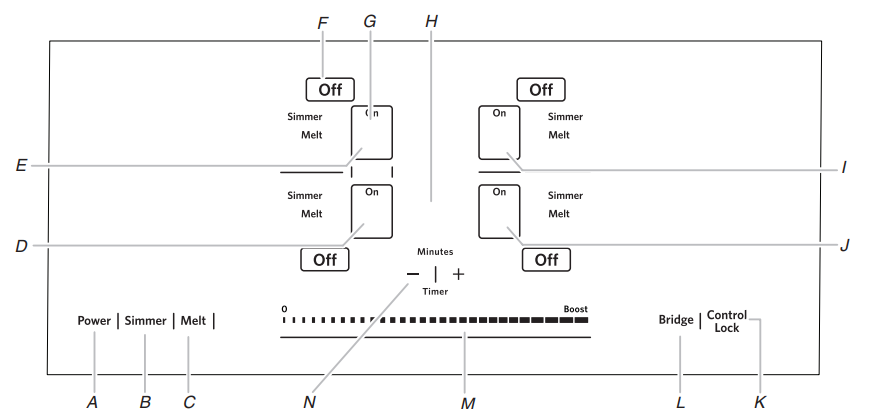
A. Cooktop power
B. Simmer
C. Melt
D. Left front surface cooking area display
E. Left rear surface cooking area display
F. Surface cooking area OFF
See other models: KSM152PSCR KSM155GBCA KSMMGA KICA0WH KSEG700EBS
G. Heat level display
H. Timer display
I. Right-rear surface cooking area display
J. Right-front surface cooking area display
K. Control lock
L. Bridge
M. Heat level slider
N. Timer (+/-)
Induction Cooking
Induction cooking is quite different from traditional forms of cooking. The heat is generated directly in the pan, keeping the cooking surface cooler than with a traditional element.
Induction cooking does not lose as much heat as traditional forms because all the heat is created in the pan itself.
The cooktop heats up or cools down quickly after the controls are set. It also stops heating when the pan is removed without turning off the power.
Food spilled on the cooktop surface will not burn because the glass is not heated. Induction cooking allows for immediate cleaning after use because the heat is created in the pan.
Pan size, material (see the “Cookware” section), and positioning are very important to achieve maximum wattage.
The diameter of the pan’s base should be equal to the size of the element.
If the pan is too small, the burner does not sense the pan and will not activate.
Cooktop Controls
The touch-activated electronic controls offer a variety of heat settings for optimal cooking results. When melting foods, such as chocolate or butter, the surface cooking area can be set to the Melt function for minimal surface cooking area operation.
For maximum surface cooking area operation, all cooktop touchactivated electronic controls can be set to the Performance Boost function when bringing liquids to a fast and rapid boil. Select the desired surface cooking area, and then press “Boost” on the heat level slider to immediately reach the highest setting. NOTE: Where 240V installation is not available, this cooktop will automatically adjust to 208V operation.
To Turn On the Cooktop:
- Press POWER. The indicator light above the Power keypad and a dash (“-”) in each surface cooking area will light to indicate that each surface cooking area is ready to be activated. Inactivity for 60 seconds after the main power has been turned on will automatically turn off the power to the cooktop. If a cooking function or the power slider is touched without first selecting a surface cooking area, all dashes (1 for each zone) will flash and an invalid tone will sound 4 times.
To Turn On a Surface Cooking Area:
- Touch directly on the display area for the surface cooking area you want to use. See D, E, I, and J of previous illustration. The current power level and indicator light will flash for 10 seconds and then remain ON. Touching any other feature or the power slider stops the flashing, and then information for the keypad that was touched will be displayed. When a surface cooking area is left at the “0” power level for 30 seconds, the surface cooking area will automatically turn off and display only the middle dash without the indicator light.
- Select a heat setting from “1” through “9” by touching/sliding on the power slider. The heat setting will appear in the surface cooking area display. The power slider consists of 9 positions plus a “Boost” position. When the user slides to “0,” “0” will be displayed. The surface cooking area will not turn on but remains active/selected. When a surface cooking area is left at the “0” power level for 30 seconds, the zone will automatically turn off and display only the middle dash without the indicator light.
IMPORTANT: The heat setting for an active cooking area may be adjusted by hand or cooking utensil above the heat level slider even if there is no contact with the cooktop glass. A beep will sound only if the slider moves to “0” or “Boost” or the cooking area is turned off.
Use the following chart as a guide when setting heat levels.

Touching the TIMER “+” or “-” keypad will turn the cooktop timer on. “01” appears in the cooktop timer display, and then the cooktop timer can be set if desired.
To Turn Off:
- Touch OFF to turn off desired surface cooking area. One tone will sound when Off is pressed.
- Touch POWER to turn off the cooktop when finished.
Hot Surface Indicator - If the cooktop power indicator light is ON, an “H” and a “0” will flash in the heat setting display of the cooking surface area that is too hot to touch. If the cooktop power indicator light is OFF, an “H” will appear in the heat setting display of the cooking surface area that is too hot to touch.
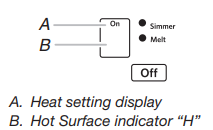
If the cooktop is ON when a power failure occurs, the Hot Surface indicator “H” will remain ON up to 45 minutes after the power is restored to the cooktop.
Simmer
The Simmer function can be used on all surface cooking areas.
To Turn On:
- Check that a surface cooking area has been selected.
- Touch SIMMER. “A” will appear in the display, and then the indicator light next to Simmer will light. The cooktop timer remains visible and can be set if desired.
To Turn Off: Touch the surface cooking area Off keypad
Melt
The Melt function can be used with all surface cooking areas.
To Use To Turn On:
- Check that a surface cooking area has been selected.
- Touch MELT. “A” will appear in the display, and then the indicator light next to Melt will light. The cooktop timer remains visible and can be set if desired.
To Turn Off: Touch the surface cooking area Off keypad.
Bridge
The Bridge function can be activated when surface cooking areas are ON or OFF. The Bridge function allows you to use 2 cooking zones as an extra-large cooking zone.
To Turn On the Bridge:
- Touch BRIDGE. The heat setting levels for the 2 left surface cooking areas will default to “0” and can be set from a minimum of “1” to a maximum of “9.” If the cooktop timer was active, it will turn off.
- Slide a finger on the heat level slider to change the power level up or down. The selected heat level will show in the heat level display for each surface cooking area using the bridge.
To Turn Off the Bridge: Touch BRIDGE. The surface cooking areas will resume operation as 2 separate areas.
Pan Detection
If the system cannot recognize the pan, or if the pan has been removed from the surface cooking area, the “replace pan” animation appears in the cooking area display as a reminder. See the following illustration.

If the pan is not placed within 30 seconds, the element(s) will switch off.
If the cooktop Timer is running when a pan is removed from the selected element, the countdown will continue until the element switches OFF.
Control Lock
The Control Lock avoids unintended use of the surface cooking areas. If Control Lock is activated when power to the cooktop is OFF, the cooktop is locked out and the surface cooking areas cannot be turned on by the cooktop touch controls.
If Control Lock is activated when power to the cooktop is ON, all keypads are locked out except for the Power and Off keypads.
To Lock Cooktop:
Touch and hold the Control Lock keypad for 3 seconds. After 3 seconds, a tone will sound and the indicator light above the Control Lock keypad will light, indicating that the cooktop controls are in the lockout position.
If the cooktop is in use when Control Lock is activated, cooking will proceed as normal and any cooktop timers that have been set will continue their countdown.
To Unlock Cooktop: Touch and hold the Control Lock keypad for 3 seconds.
Performance Boost Function
This function allows you to increase the heat setting level above the maximum heat setting “9” for 10 minutes or less.
NOTE: Performance Boost function is available on only 1 surface cooking area at a time within a zone. See the following illustration for zones.
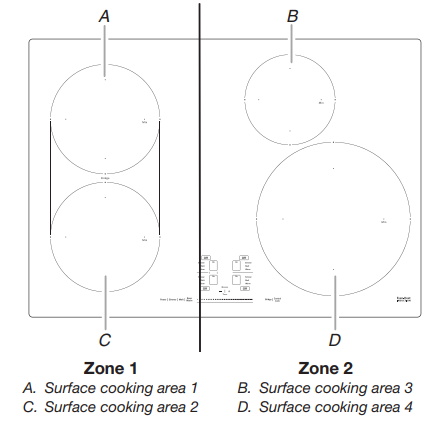
If you attempt to use Performance Boost on more than 1 surface cooking area in the same zone, “P” will briefly flash in the display, and then the first surface cooking area selected for Performance Boost will automatically be set back to the highest available power level. The last surface cooking area selected will be set to Performance Boost.
- Check that a surface cooking area has been selected.
- Touch BOOST on the heat level slider. “P” will appear in the display.
- Touch BOOST again when finished. The “P” will no longer be visible in the display and the Performance Boost function will no longer be active. The surface cooking area turns back to the highest available power level.
Timer
Use the cooktop timer to set times from 1 to 90 minutes. The cooktop timer is independent of any other control settings. The timer can be associated with only 1 surface element at a time which is indicated by blinking LEDs. The timer will not shut the surface element off at the end of the countdown.
To Use:
- Touch TIMER “+” or “-” keypad. “01” appears in the cooktop timer display.
- Touch TIMER “+” keypad to increase the time in 1-minute increments. OR Touch TIMER “-” keypad to decrease the time in 1-minute increments.
- The cooktop timer will start to count down after a few seconds. To change the time, touch TIMER “+” or “-” keypad.
- When the countdown is finished, “00” flashes and a tone will sound.
Ceramic Glass
Clean the cooktop after each use to help avoid scratches, pitting, abrasions, and to condition the glass surface. Ceramic glass cooktop cleaner and a cooktop scraper are also recommended for stubborn soils. Do not use abrasive cleaners, cleaning pads, or harsh chemicals for cleaning. The Cooktop Care Kit Part Number 31605 contains all of the items needed to clean and condition your ceramic glass cooktop. Refer to the “Range Care” section for additional information
IMPORTANT: To avoid permanent damage to the cooktop surface and to make soils easier to remove, clean the cooktop after each use to remove all soils.
- Avoid storing jars or cans above the cooktop. Dropping a heavy or hard object onto the cooktop could crack the cooktop.
- To avoid damage to the cooktop, do not leave a hot lid on the cooktop. As the cooktop cools, air can become trapped between the lid and the cooktop and the ceramic glass could break when the lid is removed.
- For foods containing sugar in any form, clean up all spills and soils as soon as possible. Allow the cooktop to cool down slightly. Then, while wearing oven mitts, remove the spills while the surface is still warm. If sugary spills are allowed to cool down, they can adhere to the cooktop and can cause pitting and permanent marks.
- To avoid scratches, do not slide cookware or bakeware across the cooktop.
- To avoid damage to the cooktop, do not allow objects that could melt, such as plastic or aluminum foil, to touch any part of the entire cooktop.
- To avoid damage to the cooktop, do not use the cooktop as a cutting board.
- Use cookware about the same size as the surface cooking area. Cookware should not extend more than ½" (1.3 cm) outside the area. Minimum pan size is also noted on the cooktop with the inner ring, if applicable.

- Use flat-bottomed cookware for best heat conduction and energy efficiency. Cookware with rounded, warped, ribbed, or dented bottoms could cause uneven heating and poor cooking results.
- Determine flatness by placing the straight edge of a ruler across the bottom of the cookware. While you rotate the ruler, no space or light should be visible between it and the cookware.

- To determine which pan to use on which induction element, measure the bottom of the flat area of your pan. Do not include the sides if they curve up. Use this measurement to help determine which induction element would best fit your pan. Manufacturer measurements listed on pans are usually for the top opening dimension. The flat bottom may be smaller.
- Make sure the bottoms of pots and pans are clean and dry before using them. Residue and water can leave deposits when heated.
Cookware
IMPORTANT: This range has induction cooktop elements. Pan size, material, and positioning are very important to achieve the best results. See “Induction Cooking” in the “Cooktop” section before using the cooktop. Only ferromagnetic pans can be used for induction cooking
Ferromagnetic Materials Include:
- Enameled steel
- Cast iron
- Stainless steel designed for induction cooking
Non-Ferromagnetic Materials Include: These types of pans will not work with induction cooking.
- Stainless steel
- Glass
- Ceramic
- Copper or aluminum pans
To find out whether your pans can be used with an induction cooktop, flip the pan over, hold a magnet to the bottom of the pan, and then see whether it sticks. If the magnet sticks to the bottom of the pan, the pan is ferromagnetic and can be used for induction cooking.
In addition, many manufacturers are now placing an “induction compatible” symbol on the bottom of their cookware or they will note compatibility on their packaging. See the following symbol.
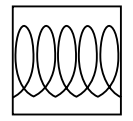
The number on the surface cooking area heat-setting display will flash if no pan is placed on the surface cooking area, the pan is not made of the right material, or it is not the right size. It will stop flashing once a suitable pan is placed on the surface cooking area. If you take longer than 30 seconds to place the correct pan on the surface cooking area, the surface cooking area will turn off. If there is no activity for 90 seconds, the cooktop will turn off.
Ideal cookware should have a flat bottom, straight sides, and a well-fitting lid, and the material should be of medium-to-heavy thickness.
Choose the correct pan size for each surface cooking area. The diameter of the pan’s base should correspond to the size of the surface cooking area.
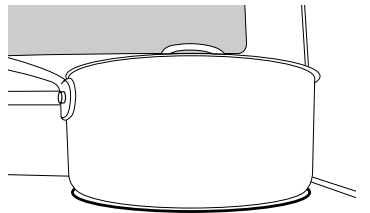
NOTE: Cookware manufacturers often give the diameter across the top of the pan. This is usually larger than the diameter of the base. Pans with rough finishes may scratch the cooktop.
Home Canning
Canning can be performed on the induction cooktop. See the “Cookware” section to check if the canner will work on the induction cooktop. When canning for long periods, alternate the use of surface cooking areas or elements between batches. This allows time for the most recently used areas to cool.
- Center the canner on the largest surface cooking area or element. On electric cooktops, canners should not extend more than 1 /2" (1.3 cm) beyond the surface cooking area or element.
- Do not place canner on 2 surface cooking areas or elements at the same time.
- On ceramic glass models, use only flat-bottomed canners to avoid damage to the cooktop and elements.
- For more information, contact your local agricultural extension office or refer to published home canning guides. Companies that manufacture home canning products can also offer assistance.
OVEN
Aluminum Foil
IMPORTANT: To avoid permanent damage to the oven bottom finish, do not line the oven bottom with any type of foil or liner.
For best cooking results, do not cover entire oven rack with foil because air must be able to move freely.
Positioning Racks and Bakeware
IMPORTANT: To avoid permanent damage to the porcelain finish, do not place food or bakeware directly on the oven door or bottom.
Bakeware
To cook food evenly, hot air must be able to circulate. Allow cm) of space around bakeware and oven walls. Make sure that no bakeware piece is directly over another.
Racks
- Position racks before turning on the oven.
- Do not position racks with bakeware on them.
- Make sure racks are level.
To position a rack, pull it out to the stop position, raise the front edge, and then lift out. Use the following illustration and charts as guides.
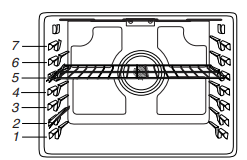
The oven has 7 positions for a flat rack, as shown in the previous illustration and the following below:
1 Large roasts or poultry
2 Roasted meats
3 or 4 Most baked goods, casseroles, frozen foods
6 Broiled meats, poultry, fish
7 Broiling/searing meats, hamburgers, steaks
For hamburger patties to have a well-seared exterior and a rare interior, use a flat rack in rack position 7. Side 1 should cook for approximately 21 /2 to 31 /2 minutes. Side 2 should cook for approximately 4 to 5 minutes. Expect a moderate degree of smoke when broiling. If your model has a Max Capacity Oven Rack, the recessed ends must be placed in the rack position above the desired position of the food. See the following illustration.
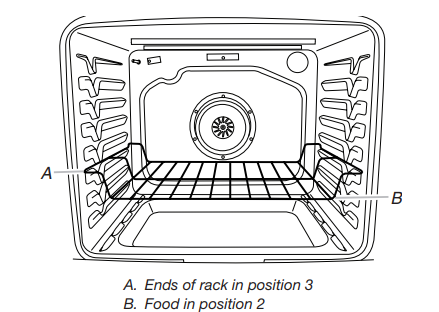
IMPORTANT: These rack positions are for flat racks. If a Max Capacity Oven Rack is used, the rack position must be adjusted as shown in the previous figure.
Multiple Rack Cooking
2-rack (non-convection): Use rack positions 2 and 5 or 3 and 6.
2-rack (convection): Use rack positions 2 and 5 or 3 and 6.
3-rack (convection): Use rack positions 2 and 7 and a Max Capacity Oven Rack in rack position 5.
Baking Cookies and Layer Cakes on 2 Racks
Baking Layer Cakes - For best results when baking cakes on 2 racks, use the Bake function, a flat rack in rack position 3, and a roll-out rack in rack position 5. Place the cakes on the racks as shown. Keep at least 3" (7.6 cm) of space between the front of the racks and the front cakes.
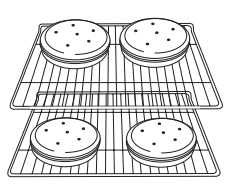
Baking Cookies - For best results when baking cookies on 2 racks, use the Convection Bake function, a flat rack in rack position 3, and a roll-out rack in rack position 4.
Roll-Out Rack
The roll-out rack allows easy access to position and remove food in the oven. It is not recommended to use the roll-out rack in the top rack, position 7, or the bottom rack, position 1.
Open Position
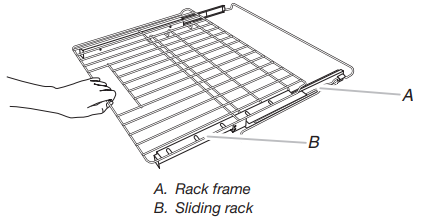
Closed and Engaged Position

To Insert Roll-Out Rack
1. Angle the front of the rack assembly up, and then insert the rack frame into the “V” cutout in the rack guides of the oven cavity.

2. Keep rack assembly lifted up at an angle, and then push in to bypass the lower “V” cutout.
3. Lower the front of the rack assembly, and then gently slide rack assembly into oven, bypassing the “V” cutouts. Push the rack assembly into the oven until it stops at the ladder in the back of the oven.
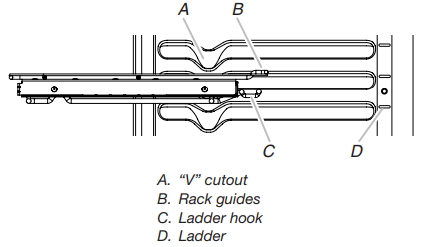
4. Reach through the rack to hold the sliding rack and the front crossbar. Lift the front of the rack assembly, and then push the rack assembly to the back of the oven. Lower the front of the rack assembly so the ladder hook engages with the ladder on both sides of the oven.
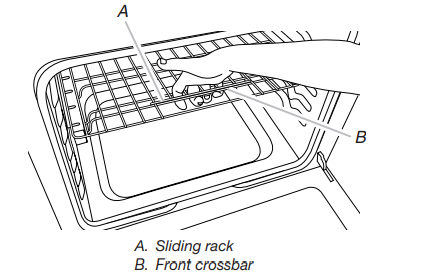
To Remove Roll-Out Rack
- Push the sliding rack in completely so that it is in the closed and engaged position.
- Reach through the rack to hold the sliding rack and the front crossbar. Lift the front of the rack assembly to disengage the ladder hook from the ladders at the rear of the oven, and then pull the rack assembly forward.
- Using 2 hands, gently pull the sliding rack and the rack frame at the same time to the “V” cutout. Angle the rack so that the front is higher than the back, and then gently pull rack past “V” cutout and then out of the oven
To avoid damage to the sliding rack, do not place more than 25 lbs (11.4 kg) on the rack. Do not clean the roll-out rack in a dishwasher. It may remove the rack’s lubricant and affect its ability to slide. See the “General Cleaning” section for more information.
Oven Vent
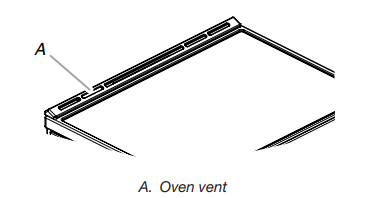
The oven vent releases hot air and moisture from the oven and should not be blocked or covered. Blocking or covering the vent will cause poor air circulation, affecting cooking and cleaning results. Do not set plastics, paper, or other items that could melt or burn near the oven vent.
Sabbath Mode
The Sabbath mode sets the oven to remain on in a bake setting until turned off. When the Sabbath mode is set, only the Bake cycle will operate. All other cooking and cleaning cycles are disabled. No tones will sound and the displays will not indicate temperature changes. When the oven door is opened or closed, the oven light will not turn on or off and the heating elements will not turn on or off immediately.
To Enable Sabbath Mode Capability (One Time Only):
- Press CLOCK/TOOLS until “SABBATH” is displayed. “OFF. Press (1) for On” will scroll in the display.
- Press the “1” keypad. “ON. Press (1) for Off” will scroll in the display. Sabbath mode can be activated for baking.
- Press START or CANCEL UPPER to exit and display the time of day. NOTE: To disable the Sabbath mode, repeat steps 1 through 3 to change the status from “SABBATH ON” to “SABBATH OFF.”
To Activate Sabbath Mode:
- Press BAKE for the desired oven.
- Press the number keypad to set a temperature other than 350°F (177°C).
- Press START. For timed cooking in Sabbath mode, press COOK TIME and then the number keypads to set the desired cook time.
- Press CLOCK/TOOLS. Three tones will sound. Then press “7.” “SAb” will appear in the display.
To Adjust Temperature (When Sabbath Mode Is Running):
- Press the number keypad as instructed by the scrolling text to select the new temperature. NOTE: The temperature adjustment will not appear on the display. The scrolling text will be shown on the display as it was before the keypad was pressed.
- Press START.
To Deactivate Sabbath Mode: Press CLOCK/TOOLS, and then press “7” to return to regular baking, or press CANCEL for the desired oven to turn off the range. NOTE: No tones will sound while deactivating Sabbath mode.
Baking and Roasting
Preheating
When beginning a Bake, Convect Bake, or Convect Roast cycle, the oven will begin preheating after Start is pressed. The oven will take approximately 12 to 15 minutes to reach 350°F (177°C) with all of the oven racks provided with your oven inside the oven cavity. Higher temperatures will take longer to preheat. The preheat cycle rapidly increases the oven temperature. The actual oven temperature will go above your set temperature to offset the heat lost when your oven door is opened to insert food. This ensures that when you place your food in the oven, the oven will begin at the proper temperature. Insert your food when the preheat tone sounds. Do not open the door during preheat before the tone sounds.
Oven Temperature
While in use, the oven elements will cycle on and off as needed to maintain a consistent temperature, but they may run slightly hot or cool at any point in time due to this cycling. Opening the oven door while in use will release the hot air and cool the oven which could impact the cooking time and performance. It is recommended to use the oven light to monitor cooking progress. NOTE: On models with convection, the convection fan may run in the non-convection Bake mode to improve oven performance.
Temperature Management System
The Temperature Management System electronically regulates the oven heat levels during preheat and Bake to maintain a precise temperature range for optimal cooking results. The bake and broil elements or burners cycle on and off in intervals. On convection range models, the fan will run while preheating and may be cycled on and off for short intervals during Bake to provide the best results. This feature is automatically activated when the oven is in use.
Before baking and roasting, position racks according to the “Positioning Racks and Bakeware” section. When roasting, it is not necessary to wait for the oven preheat cycle to end before putting food in, unless it is recommended in the recipe.
Steam Bake
The Steam Bake function works in conjunction with the steam rack to provide additional moisture during baking. The steam rack contains a water reservoir which heats up and releases steam into the oven cavity during the Steam Bake cycle. There are 3 preprogrammed food options to choose from: Breads, Desserts, and Fish as well as a Refresh/Reheat option.
For best performance, place the steam rack in the lowest available rack position in the cavity and pour 11 /2 cups (350 mL) of water into the reservoir. Do not fill past the MAX level indicated on the reservoir.
After the Steam Bake cycle is complete, some water may remain in the reservoir. This is normal. Wait for the oven to cool and discard the water.
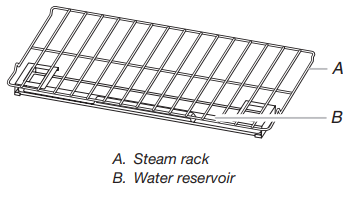
Broiling
When broiling, preheat the oven for 2 minutes before putting food in, unless recommended otherwise in the recipe. Position food on grid in a broiler pan, and then place it in the center of the oven rack.
IMPORTANT: Close the door to ensure proper broiling temperature.
Changing the temperature when broiling allows more precise control when cooking. The lower the broil setting is, the slower the cooking. Thicker cuts and unevenly shaped pieces of meat, fish, and poultry may cook better at lower broil settings. Use rack 6 or 7 for broiling. Refer to the “Positioning Racks and Bakeware” section for more information.
On lower settings, the broil element will cycle on and off to maintain the proper temperature.
- For best results, use a broiler pan and grid. It is designed to drain juices and help avoid spatter and smoke. If you would like to purchase a broiler pan, one may be ordered. See the “Accessories” section.
Convection Cooking
In a convection oven, the fan-circulated hot air continually distributes heat more evenly than the natural movement of air in a standard thermal oven. This movement of hot air helps maintain a consistent temperature throughout the oven, cooking foods more evenly, crisping surfaces while sealing in moisture and yielding crustier breads.
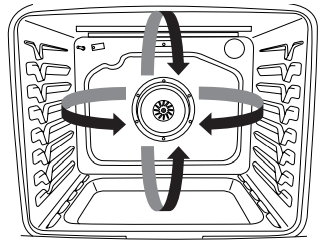
During convection baking or roasting, the bake, broil, and convection elements cycle on and off in intervals while the fan circulates the hot air. During convection broiling, the broil and convection elements cycle on and off.
If the oven door is opened during convection cooking, the fan will turn off immediately. It will come back on when the oven door is closed.
With convection cooking, most foods can be cooked at a lower temperature and/or a shorter cooking time than in a standard thermal oven. When using Manual Convect modes, reduce the time and temperature when setting the oven. Use the following chart as a guide.
Convection Mode
- Convection Bake: 25°F (15°C) lower temperature, possible shortened cooking time
- Convection Roast: Cooking time shortened by up to 30%
- Convection Broil: Shortened cooking time
Convect Options
- Convect Bake - multiple-rack baking or cookies, biscuits, breads, casseroles, tarts, tortes, cakes
- Convect Roast - whole chicken or turkey, vegetables, pork roasts, beef roasts
- Convect Broil - thicker cuts or unevenly shaped pieces of meat, fish, or poultry
Proofing Bread
Proofing bread prepares the dough for baking by activating the yeast. Follow the recipe directions as a guide. Proof should be used for fresh dough, thawed dough, and for the first and second rise.
To Proof: Before first proofing, place the dough in a lightly greased bowl and cover loosely with wax paper, coated with shortening. Place on rack guide 2 and close the oven door. NOTE: If the temperature of the oven is greater than 120°F (49°C), “Oven Cooling” will be displayed until the temperature is less than 120°F (49°C).
- Press PROOF.
- Press START. Let the dough rise until nearly doubled in size. Proofing time may vary depending on dough type and quantity.
- Press CANCEL UPPER when finished proofing.
Before second proofing, shape the dough, place it in baking pan(s), and cover loosely. Follow the same placement and control steps above. Before baking, remove the cover.
NOTE: If the oven temperature is greater than 120°F (49°C), the display will indicate “Oven Cooling” until the temperature is below 120°F (49°C).
Cook Time
To Set a Timed Cook:
- Press BAKE or BROIL or press an Easy Convect function.
- Press the number keypads to enter a temperature other than the one displayed.
- Press COOK TIME. The Cook Time oven indicator light will light up.
- Press the number keypads to enter the length of time to cook.
- Press START. The display will count down the time. When the time ends, the oven will shut off automatically.
- Press CANCEL for the desired oven to clear the display.
To Set a Delayed Timed Cook:
- Press BAKE or BROIL or press an Easy Convect function.
- Press the number keypads to enter a temperature other than the one displayed.
- Press COOK TIME. The Cook Time oven indicator light will light up.
- Press number keypads to enter the length of time to cook.
- Press DELAY START.
- Press number keypads to enter the number of hours and/or minutes you want to delay the start time.
- Press START. When the start time is reached, the oven will automatically turn on. The temperature and/or time settings can be changed anytime after the oven turns on by repeating steps 2 through 4. When the set cook time ends, the oven will shut off automatically.
- Press CANCEL for the desired oven to clear the display.
Meat Probe
The meat probe accurately measures the internal temperature of meat, poultry, and casseroles with liquid and should be used in determining the doneness of meat and poultry.
This meat probe operates as an independent device and is not plugged into the oven. Follow the meat probe directions for using the meat probe.
To avoid damage to the meat probe, do not leave the meat probe in self-cleaning ovens while the cycle is running.
Baking Drawer
The baking drawer is highly recommended for baking frozen foods. Use the temperature and medium cook time given on the frozen food packaging. For example, if the packaging suggests a cook time of 15 to 20 minutes, set the cook time for 17 minutes. Check food for doneness before removing from the baking drawer.
The baking drawer may also be used for conventional baking, slow cooking, and keeping hot cooked foods warm. It is not recommended to prepare foods taller than the height of the baking drawer rack handles or foods that may rise above 21 /2" (6.4 cm) in the baking drawer.
IMPORTANT: Always use the baking drawer rack when using the baking drawer.
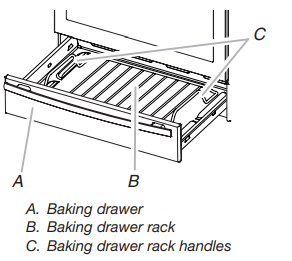
To Bake with the Baking Drawer:
- Press BAKING DRAWER BAKE.
- Set the desired temperature between 170°F and 451°F (75°C and 233°C) using the number keypads. The default temperature is 350°F (180°C).
- Press START.
- To change the temperature, repeat steps 2 and 3.
- Press CANCEL LOWER when finished. 6. Remove food from the drawer.
To Slow Cook with the Baking Drawer:
IMPORTANT: Brown roasts thoroughly before starting to slow cook.
- Place food in the Baking Drawer.
- Press BAKING DRAWER SLOW COOK.
- Set the desired temperature between 145°F and 190°F (63°C and 88°C) using the number keypads. The default temperature is 170°F (75°C).
- Press START.
- (Optional) Set the desired cook time using the number keypads.
- Press START.
- Press CANCEL LOWER when finished.
- Remove food from the baking drawer.
To Keep Warm with the Baking Drawer: Food must be at serving temperature before placing it in the warmed drawer.
- Place food in the baking drawer.
- Press BAKING DRAWER KEEP WARM.
- Set the desired temperature between 145°F and 190°F (63°C and 88°C) using the number keypads. The default temperature is 170°F (75°C).
- Press START.
- Press CANCEL LOWER when finished.
- Remove food from the baking drawer.
Oven Light
The oven light is a standard 40-watt appliance bulb. Before replacing, make sure the oven and cooktop are cool and the control knobs are in the Off position. To Replace:
- Unplug range or disconnect power.
- Turn the glass bulb cover in the back of the oven counterclockwise to remove.
- Turn bulb counterclockwise to remove from socket.
- Replace bulb by turning clockwise.
- Replace bulb cover by turning clockwise.
- Plug in range or reconnect power.
RANGE CARE
Self-Clean Cycle
AquaLift® Technology is an innovative cleaning solution that utilizes heat and water to release baked-on spills from the oven in less than 1 hour. This new cleaning technology is a low-heat, odorfree alternative to traditional Self-Cleaning options.
Allow the oven to cool to room temperature before using the SelfCleaning cycle. If your oven cavity is above 200°F (93°C), “Oven Cooling” will appear in the display and the Self-Cleaning cycle will not be activated until the oven cavity cools down.
To Clean:
1. Remove all racks and accessories from the oven cavity and wipe excess soil. Use a plastic scraper to remove easily removed soils.
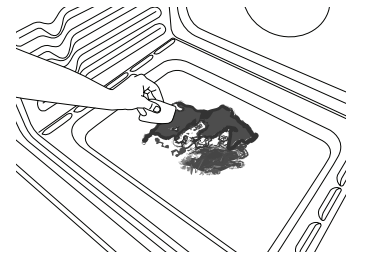
2. Pour 2 cups (16 oz [500 mL]) of distilled or filtered water onto the bottom of the empty oven and close the oven door.
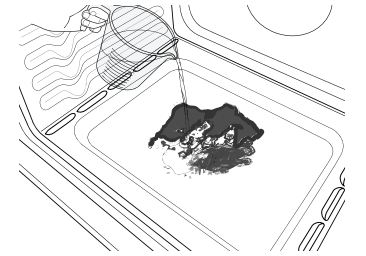
IMPORTANT: Do not use chemicals or other additives with the water. Do not open the oven door during the Self-Cleaning cycle. The water on the oven bottom is hot.
3. Press AQUALIFT SELF CLEAN and then START on the oven control panel.
4. Allow 40 minutes for cleaning and cooldown. A beep will sound when the Self-Cleaning cycle is complete.
5. Press CANCEL UPPER at the end of the cycle. Cancel Upper may be pressed at any time to stop the Self-Cleaning cycle.
6. Remove the residual water and loosened soils with a sponge or cloth immediately after the Self-Cleaning cycle is complete. Much of the initial 2 cups (16 oz [500 mL]) of water will remain in the oven after the cycle is completed. If additional soils remain, leave a small amount of water in the oven bottom to assist with the cleaning.

7. If any soils remain, remove them with a non-scratch scrubbing sponge or plastic scraper. Additional Self-Cleaning cycles may be run to help remove the stubborn soils. IMPORTANT: Do not use oven cleaners. The use of chemicals, including commercial oven cleaners or metal scouring pads, may cause permanent damage to the porcelain surface of the oven interior.
General Cleaning
EXTERIOR PORCELAIN ENAMEL SURFACES (on some models): Food spills containing acids, such as vinegar and tomato, should be cleaned as soon as the entire range is cool. These spills may affect the finish.
Cleaning Method:
- Glass cleaner, mild liquid cleaner, or nonabrasive scrubbing pad: Gently clean around the model/serial/rating plate because scrubbing may remove numbers.
- affresh® Kitchen and Appliance Cleaner Part Number W10355010 (not included): See the “Accessories” section for more information.
STAINLESS STEEL (on some models): To avoid damage to stainless steel surfaces, do not use soap-filled scouring pads, abrasive cleaners, Cooktop Cleaner, steel-wool pads, gritty washcloths, or abrasive paper towels. Damage may occur to stainless steel surfaces, even with one-time or limited use.
Cleaning Method: Rub in direction of grain to avoid damaging.
- affresh® Stainless Steel Cleaner Part Number W10355016: See the “Accessories” section for more information.
METALLIC PAINT (on some models): Do not use abrasive cleaners, cleaners with bleach, rust removers, ammonia, or sodium hydroxide (lye) because paint surface may stain.
CERAMIC GLASS: To avoid damaging the cooktop, do not use steel wool, abrasive powder cleansers, chlorine bleach, rust remover, or ammonia.
1. Remove food/residue with the Cooktop Scraper.
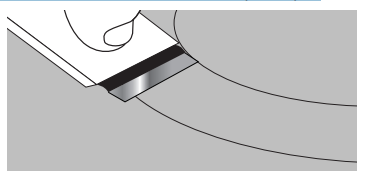
- For best results, use the Cooktop Scraper while the cooktop is still warm but not hot to the touch. It is recommended to wear an oven mitt while scraping the warm cooktop.
- Hold the Cooktop Scraper at approximately a 45° angle against the glass surface and scrape the residue. It will be necessary to apply pressure in order to remove the residue.
Allow the cooktop to cool down completely before proceeding to Step 2.
2. Apply a few dime-sized drops of affresh® Cooktop Cleaner to the affected areas.
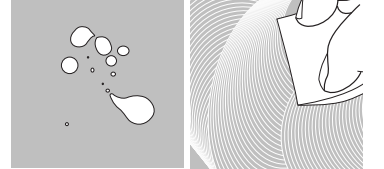
- Rub affresh® Cooktop Cleaner onto the cooktop surface with the blue Cooktop Cleaning Pad. Some pressure is needed to remove stubborn stains.
- Allow the cleaner to dry to a white haze before proceeding to Step 3.
3. Polish with a clean, dry cloth or a clean, dry paper towel.

- Repeat steps 1 through 3 as necessary for stubborn or burned-on stains.
The Complete Cooktop Cleaner Kit is available for order including the following:
- Cooktop Scraper
- affresh® Cooktop Cleaner
- Blue Cooktop Cleaning Pads
CONTROL PANEL AND OVEN DOOR EXTERIOR: To avoid damage to the control panel, do not use abrasive cleaners, steel-wool pads, gritty washcloths, or abrasive paper towels.
Cleaning Method:
- Glass cleaner and soft cloth or sponge: Apply glass cleaner to soft cloth or sponge, not directly on panel.
- affresh® Kitchen and Appliance Cleaner Part Number W10355010 (not included): See the “Accessories” section for more information.
OVEN RACKS
Cleaning Method:
- Steel-wool pad
- For racks that have discolored and are harder to slide, a light coating of vegetable oil applied to the rack guides will help them slide.
- Dishwasher (steam rack water reservoir only, not racks): Although the water reservoir is durable, it may lose its shine and/or discolor when washed in a dishwasher.
BAKING DRAWER: Check that baking drawer is cool and empty before cleaning. Food spills should be cleaned when oven cools. At high temperatures, foods react with porcelain. Staining, etching, pitting, or faint white spots can result.
Cleaning Method: Mild detergent
OVEN CAVITY: Use AquaLift® Technology regularly to clean oven spills. Do not use oven cleaners. Food spills should be cleaned when oven cools. At high temperatures, foods react with porcelain. Staining, etching, pitting, or faint white spots can result.
Cleaning Method: Self-Cleaning cycle: See the “Clean Cycle” section first.
Remove/Replace Drawer
Remove all items from inside the baking drawer, and then allow the range to cool completely before attempting to remove the drawer.
To Remove:
1. Open the drawer to its fully open position.
2. Using a flat-blade screwdriver, gently loosen the drawer from the glide alignment notch, and then lift up the drawer alignment tab from the glide.
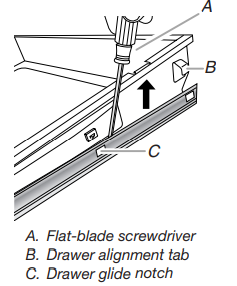
3. Repeat Step 2 on the other side. The drawer is no longer attached to the drawer glides. Using both hands, pick up the drawer to complete the removal.
To Replace:
1. Align the forward drawer notches with the notches in the drawer glides on both sides. Place the rear alignment tabs into the drawer glides on both sides.
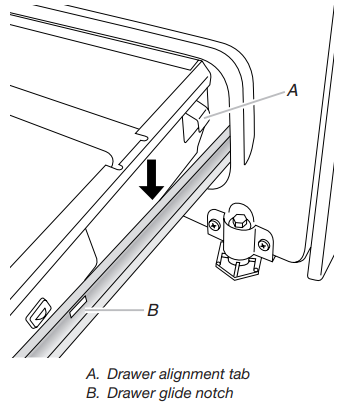
2. Push the drawer in all the way.
3. Gently open and close the drawer to ensure it is seated properly on the glides on both sides.
TROUBLESHOOTING
Operation
Nothing will operate
- Power supply cord is unplugged - Plug into a grounded outlet.
- Household fuse is blown or a circuit breaker is tripped - Replace the fuse or reset the circuit breaker. If the problem continues, call an electrician.
Cooktop will not operate
- The control knob is set incorrectly - Touch the display area on the control panel to select a cooking surface before selecting a function.
- The cooktop control lockout is set - See “Control Lock” in the “Cooktop” section.
- Cooktop is turned off - The Power keypad was unintentionally touched. Press POWER again. Reset the cooktop.
Cooktop cooking results not what expected
- Improper cookware being used - See the “Cookware” section.
- Cooktop control set to incorrect heat level - See “Cooktop Controls” in the “Cooktop” section.
- Range is not level - Level the range. See the Installation Instructions.
Oven will not operate
- The electronic oven control was set incorrectly - See the “Electronic Oven Controls” section. Delay Start is set - See the “Cook Time” section.
- The oven control lockout is set - See the Control Lock keypad feature in the “Feature Guide” section.
- The range is in Demo mode - Demo mode will deactivate all oven elements. See “Demo Mode” in the “Electronic Oven Controls” section.
Oven temperature too high or too low
- Oven temperature calibration needs adjustment - See “Oven Temperature Control” in the “Electronic Oven Controls” section.
Oven indicator lights flash
- Needs service (oven indicator lights are flashing) - See “Control Display” in the “Electronic Oven Controls” section. If the indicator light(s) keep flashing, call for service. See the “Warranty” section for contact information.
Oven control displays messages
- Power failure (display shows flashing time) - Clear the display. On some models, reset the clock, if needed. See “Clock” keypad feature in the “Feature Guide” section.
- Error code (display shows letter followed by number) - Press CANCEL to clear the display. See “Control Display” in the “Electronic Oven Controls” section. If it reappears, call for service. See the “Warranty” section for contact information.
Cooktop display shows messages
- Improper pan being used (“replace pan” animation showing in the display when you place a saucepan on an induction surface cooking area) - See “Pan Detection” in the “Cooktop” section. Check that the saucepan is ferromagnetic. Check that the diameter of the saucepan is large enough. Center the saucepan on the surface cooking area. Allow the saucepan to cool down in the event that it has become hot when used. Switch the surface cooking area off and then on again. If the display still does not light up, turn power off at the circuit breaker. Wait 20 seconds and turn power back on.
- Long cooking time (performance Boost function display flashing and switching off) - The Performance Boost function operates the surface cooking area with the most power. During long cooking times, it is possible that the function will switch the surface cooking area off to keep the cooktop from overheating. You can continue to use the cooktop if the display is not flashing.
- Error code (display flashing “Er” and numbers) - If an “Er” and a series of numbers appear in the display panel, turn power off at the circuit breaker. Turn on again. If problem continues, call customer service. See the “Warranty” section for contact information.
Is the display flashing “F” or “C” and numbers? If “F” or “C” and a number are alternately flashing on the display, refer to the following for possible solutions:
Cooktop has turned off and is beeping every 10 seconds
- An object, liquids, or soils are putting pressure on the control panel - Thoroughly wipe or remove any object on touch keypads.
F42, F43
- The power voltage is too low or too high - Turn off the cooktop. Wait 5 seconds, and then turn it back on. If this continues, contact a qualified electrician.
C81, C82, C83
- The surface cooking area has overheated - The surface cooking area automatic shutoff was activated. Wait 5 minutes for it to cool down, and then turn it back on.
F12, F21, F25, F36, F37, F40, F47, F56, F58, 560, F61, F62, F63, F64
- Call for service. See the “Warranty” section for contact information. Self-Cleaning cycle did not work on all spills Several cooking cycles between Self-Cleaning cycles or spills on oven walls and doors - Run additional Self-Cleaning cycles. Use the AquaLift® Technology Cleaning Kit. affresh® Kitchen and Appliance Cleaner or affresh® Cooktop Cleaner can be used for stubborn soils. See the “Accessories” section for more information.
Mineral deposits are left on the oven bottom after the Self-Cleaning cycle
- Tap water was used in the Self-Cleaning cycle - Use distilled or filtered water in the Self-Cleaning cycle. To remove deposits, use a cloth soaked with vinegar. Then use a cloth dampened with water to thoroughly remove any vinegar residue.
- Range is not level - Mineral deposits will collect on dry areas of the oven bottom during the SelfCleaning cycle. Level the range. See the Installation Instructions. To remove deposits, use a cloth soaked with vinegar. Then use a cloth dampened with water to thoroughly remove any vinegar residue.
Oven cooking results not what expected
- Range is not level - Level the range. See the Installation Instructions.
- The set temperature was incorrect - Double-check the recipe in a reliable cookbook.
- Oven temperature is calibrated incorrectly - See “Oven Temperature Offset Control” in the “Electronic Oven Controls” section.
- Oven was not preheated - See the “Baking and Roasting” section.
- Racks were positioned improperly - See the “Positioning Racks and Bakeware” section.
- Not enough air circulation around bakeware - See the “Positioning Racks and Bakeware” section.
- Batter distributed unevenly in pan - Check that batter is level in the pan.
- Darker browning of food caused by dull or dark bakeware - Lower oven temperature 25°F (15°C) or move rack to a higher position in the oven.
- Lighter browning of food caused by shiny or light-colored bakeware - Move rack to a lower position in the oven.
- Incorrect length of cooking time was used - Adjust cooking time.
- Oven door was not closed - Be sure that the bakeware does not keep the door from closing.
- Oven door was opened during cooking - Oven peeking releases oven heat and can result in longer cooking times.
- Rack is too close to bake burner, making baked items too brown on bottom - Move rack to higher position in the oven.
- Pie crusts browning too quickly - Use aluminum foil to cover the edge of the crust and/or reduce baking temperature.
- Temperature scale was changed from Fahrenheit to Celsius - Foods are overdone or burnt even at low temperatures. See “Fahrenheit and Celsius” in the “Electronic Oven Controls” section.
Operational cooktop sounds: The following are some normal sounds with the explanations. These sounds are normal operational noises.
Low humming
- This occurs when cooking at high power. The cause of this is the amount of energy that is transmitted from the appliance to the cookware - This sound will lessen or go away when the power is turned down.
Crackling
- Cookware is used that consists of different materials. The noise is caused by vibrations in the joint faces between the different layers - The sound may change depending on the amount and type of food being cooked.
Fan noise
- The electronics require a controlled temperature in order to function reliably - The cooktop is fitted with a fan that runs at various speeds according to the temperature detected. The fan may also continue to run even after the cooktop has been switched off if the temperature it detects is too high.
